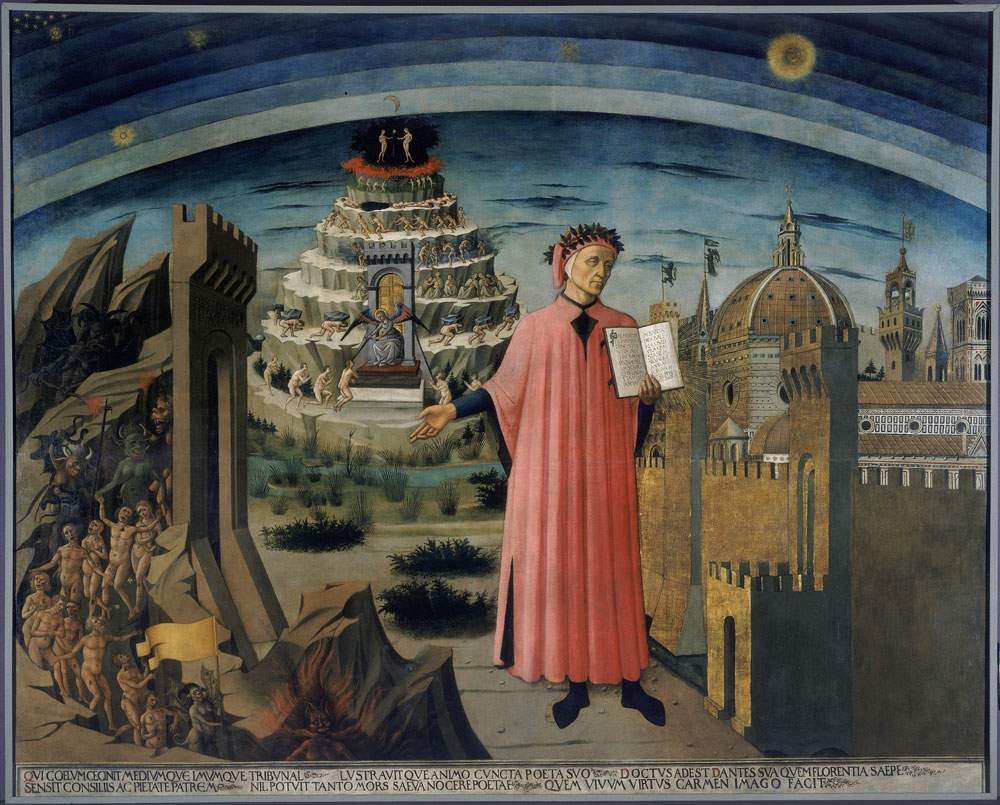Made an installation to get a closer look at Florence Cathedral's Portrait of Dante
From May 14 to Dec. 31, 2021, it will be possible for the first time, thanks to a special installation, to see up close the famous Portrait of Dante Alighieri, the City of Florence and the Allegory of the Divine Comedy, painted by Domenico di Michelino in 1465 for Florence Cathedral. The close-up view of the masterpiece that constitutes the Dante and the Light of the Comedy initiative in Santa Maria del Fiore, curated by Antonio Natali, is part of the program of initiatives on the occasion of Dante’s celebrations for the seven hundredth anniversary of the Supreme Poet’s death. The celebrations see three prestigious Florentine institutions collaborating for the first time , namely the Opera di Santa Maria del Fiore, the Opera di Santa Croce and the Certosa di Firenze - Comunità di San Leolino.
“Domenico di Michelino’s work is perhaps the best-known portrait of Dante Alighieri,” says Antonio Natali, “and it is no coincidence that in 2021 it has been asked to be loaned for many exhibitions (starting with those that are receiving the most attention from the press and television stations); however, it seemed unacceptable to us, precisely in Dante’s year, to deprive Florence Cathedral for several months of a creation that the Opera di Santa Maria del Fiore had wanted to commission in the 15th century to celebrate his birth.”
TheOpera di Santa Maria del Fiore commissioned this painted monument in 1465, on the occasion of the two hundredth anniversary of Dante’s birth, precisely to exalt the poet’s memory in the main Florentine church. The portrait was to replace an earlier lost painting, made in the 1420s by a painter named Mariotto (identifiable as Mariotto di Nardo or Mariotto di Cristofano, Masaccio’s brother-in-law) and centered on the theme of the return of the poet’s ashes to his homeland.
The one in Santa Maria del Fiore is an allegorical portrait of Dante, depicted standing with a laurel wreath encircling his head, and in his left hand Dante holds the Commedia open on the opening verses, while with his right hand he points to the Gates of Hell. Behind him are Purgatory and Paradise. “Restrained in a symbolic setting, evocative of the places of the three canticles,” writes Antonio Natali, “he turns his pensive gaze toward a lyrical epiphany of Florence; which, enclosed within crenellated walls, overlaps its architecture, topped by Brunelleschi’s imposing and now completed dome. The city stands opposite the gate of Hell.”
Depicted here is a 15th-century Florence with Brunelleschi’s Cathedral and Dome, already crowned by the gold-covered bronze ball and cross, which at the time of the painting had not yet been executed but which the artist had seen in the model designed by Brunelleschi in 1419. Also seen are the walls of the second circle, begun in 1172, the towers of the Bargello, the Florentine Badia church, the Palazzo Vecchio, and Giotto’s Campanile.
According to art historian Annamaria Bernacchioni, who has long studied this painting and its author, “Domenico di Michelino probably drew inspiration from earlier portraits: the Giottesque one in the Bargello Chapel, the other by Taddeo Gaddi in Santa Croce (destroyed by Vasari), and the late 14th-century examples in the vanished Aula minor of the Palazzo Vecchio and the Palazzo del Proconsolo, up to the portrait by Andrea del Castagno in the Villa Carducci in Legnaia.”
“Here Dante is portrayed tetragonal (Par. XVII, v.22), that is, resolute in exile,” says Dante scholar Jason Houston, “as he fixes his solemn gaze on the city of Florence and with a suggestive gesture of his hand points to the gates of Hell. Dante holds open the Comedy, inviting the visitor to consider his words carefully.”
The Dante and the Light of the Comedy initiative in Santa Maria del Fiore is made possible thanks to LAYHER S.p.A. for the installation structures and Fabio Falciani for the conservation work.
Image: Domenico da Michelino, Portrait of Dante Alighieri, the City of Florence and the Allegory of the Divine Comedy (1465; Florence, Cathedral) Courtesy Opera di Santa Maria del Fiore
 |
| Made an installation to get a closer look at Florence Cathedral's Portrait of Dante |
Warning: the translation into English of the original Italian article was created using automatic tools. We undertake to review all articles, but we do not guarantee the total absence of inaccuracies in the translation due to the program. You can find the original by clicking on the ITA button. If you find any mistake,please contact us.




























